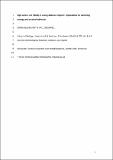High winter site fidelity in a long-distance migrant : implications for wintering ecology and survival estimates
Date
01/2016Metadata
Show full item recordAbstract
The decision for a migratory animal to be site faithful in its non-breeding season has profound implications for migratory connectivity, resilience to winter habitat loss and population dynamics through carry-over effects on future breeding success and fitness. Knowledge of the temporal and spatial scale of site fidelity and dispersal is also central to accurate survival estimates. We established the observed spatial and temporal scale of site fidelity and the ability to detect small-scale dispersal within and between years for a wintering long-distance Palearctic migrant, the Whinchat Saxicola rubetra, by comparing predicted and observed detection rates within the study site. Across two years, 54% of birds returned to the study site and all returning birds reoccupied the territories they used in the previous winter. Observed dispersal was very low despite the high probability of detecting any local dispersal, suggesting that return rates are indicative of true between-winter survival rates for this population. In any winter, 50% of returning individuals had a previously occupied but now empty territory that was less than one territory-span away from the centre of their current territory; high site fidelity was therefore very unlikely to be because of limited territory availability. Over-winter residency time (defined by departure month) differed significantly across sites and with age, but did not determine the probability of whether a bird returned in the following year. This suggests the use of more than one wintering site for some individuals, rather than reduced over-winter survival. This study is one of the first to comprehensively document site fidelity at the territory scale in a Palearctic system, although less comprehensive studies or anecdotal evidence suggest that high winter site fidelity may be relatively common. Here we provide evidence for the serial residency hypothesis, where selection acts for individual migrants to have generalist habitat requirements, allowing them to survive in and remain site faithful to even relatively low quality, but sufficient and familiar sites. Lower dispersal and higher site fidelity compared to that during breeding suggest that annual survival estimates are more accurate when measured on the wintering grounds. This study supports previous findings that wintering conditions do not limit Whinchat populations.
Citation
Blackburn , E & Cresswell , W 2016 , ' High winter site fidelity in a long-distance migrant : implications for wintering ecology and survival estimates ' , Journal of Ornithology , vol. 157 , no. 1 , pp. 93-108 . https://doi.org/10.1007/s10336-015-1252-z
Publication
Journal of Ornithology
Status
Peer reviewed
ISSN
2193-7192Type
Journal article
Description
This research was funded by the Leventis Conservation Foundation.Collections
Items in the St Andrews Research Repository are protected by copyright, with all rights reserved, unless otherwise indicated.

